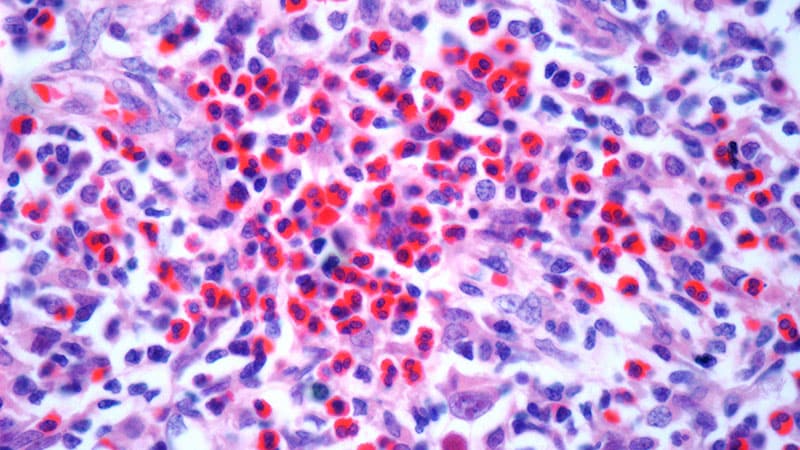Safety of Skipping PET2 After Brentuximab in Hodgkin Lymphoma
Core Concepts
Patients with Hodgkin lymphoma receiving brentuximab vedotin may safely skip PET2 scans without impacting outcomes.
Abstract
The research presented at the 2023 Society of Hematologic Oncology (SOHO) Annual Meeting suggests that patients with Hodgkin lymphoma who receive frontline brentuximab vedotin may be able to safely skip their interim PET-CT scan (PET2) after two cycles of treatment. The addition of brentuximab vedotin to AVD chemotherapy has shown improved outcomes for patients, regardless of PET2 scan results. While interim PET-CT scans are standard for Hodgkin lymphoma patients, the study indicates that PET2 may not be necessary when brentuximab vedotin is part of the treatment regimen. The data reviewed by lead investigator Ravand Samaeekia, MD, MSc, suggests that PET2 results did not significantly impact patient management or outcomes in the studies analyzed.
Key Highlights:
Brentuximab vedotin with AVD chemotherapy improves outcomes for Hodgkin lymphoma patients.
PET2 scans may not be necessary when brentuximab vedotin is part of the treatment.
PET2 results did not alter treatment for most patients in the studies reviewed.
Safely Skip PET2 After Brentuximab in Hodgkin Lymphoma?
Stats
"6-year overall survival favored patients with advanced Hodgkin lymphoma who received brentuximab and were PET2-negative (94.9% vs 90.6%; hazard ratio [HR], for death, 0.54) as well as those who were PET2-positive (95% vs 77%; HR, 0.16)."
"3-year event-free survival was significantly higher among adolescents and children with Hodgkin lymphoma who received brentuximab — 90.7% for those who had slow-responding lesions and 92.3% for those with rapid-responding lesions."
"All patients who were PET2-negative remained negative on the end-of-treatment PET, indicating no cancer progression."
Quotes
"PET2 scan results 'did not have any meaningful impact' on patient management or outcomes." - Samaeekia
"Doing a PET2 scan may make 'us feel better,' but it ultimately doesn't 'make any difference in our management.'" - Samaeekia
Key Insights Distilled From
by Neil Osterwe... at www.medscape.com 09-13-2023
https://www.medscape.com/viewarticle/996393
Deeper Inquiries
How might the findings of this study impact current treatment guidelines for Hodgkin lymphoma patients?
The findings of this study suggest that in Hodgkin lymphoma patients receiving frontline brentuximab vedotin alongside chemotherapy, the interim PET-CT scan (PET2) may not significantly impact patient management or outcomes. This could potentially lead to a shift in current treatment guidelines, allowing for the safe omission of PET2 scans in certain cases. By demonstrating that PET2 results did not alter treatment decisions for the majority of patients and that incorporating brentuximab vedotin improved efficacy regardless of PET2 status, these findings may prompt a reevaluation of the necessity of routine PET2 scans in this specific patient population.
What are the potential drawbacks of omitting PET2 scans in this patient population?
While the study suggests that omitting PET2 scans following brentuximab vedotin treatment may be safe in Hodgkin lymphoma patients, there are potential drawbacks to consider. Omitting PET2 scans could lead to a lack of early detection of disease progression or treatment response, potentially delaying necessary treatment modifications. Additionally, without the information provided by PET2 scans, clinicians may have less insight into the effectiveness of the current treatment regimen, which could impact long-term outcomes for patients. Furthermore, omitting PET2 scans may limit the ability to identify patients who may benefit from alternative treatment approaches, potentially compromising individualized care.
How can the predictive value of PET2 scans be improved in the context of brentuximab vedotin treatment?
To improve the predictive value of PET2 scans in the context of brentuximab vedotin treatment for Hodgkin lymphoma patients, several strategies can be considered. One approach could involve refining the criteria used to interpret PET2 results, taking into account specific characteristics of brentuximab vedotin treatment that may influence scan findings. Additionally, incorporating other biomarkers or imaging modalities alongside PET2 scans could enhance the accuracy of predicting treatment response and disease progression. Furthermore, conducting larger prospective studies specifically focused on the predictive value of PET2 scans in brentuximab vedotin-treated patients could provide more robust evidence to guide clinical decision-making. By optimizing the interpretation and utilization of PET2 scans in the context of brentuximab vedotin treatment, clinicians can better tailor treatment strategies for Hodgkin lymphoma patients.
0
